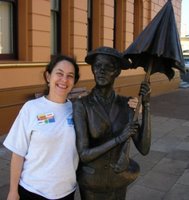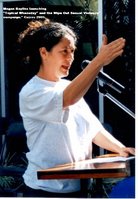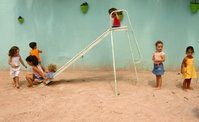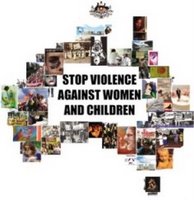 Our neighbors had a prowler last night. The mother of the female only household caught the prowler peering through the bedroom window of the teenage daughter. Mother yelled at him and sang out for the help of her neighbors. The prowler stayed. It took several attempts at calling for someone to ring the police before prowler got the hint that his behaviour was unacceptable.
Our neighbors had a prowler last night. The mother of the female only household caught the prowler peering through the bedroom window of the teenage daughter. Mother yelled at him and sang out for the help of her neighbors. The prowler stayed. It took several attempts at calling for someone to ring the police before prowler got the hint that his behaviour was unacceptable.
Peeping Tom behavior is voyeurism. It is against the law. It is a form of sexual assault. Sexual abuse occurs on a continuum ranging from non-contact behaviors at one end (voyeurism, showing children pornography, and sexual comments) through to penetration by use of a penis, fingers or an object at the other end.
Many sexual predators escalate in their behaviors. Their excitement increases and their ability to delay their own twisted sexual gratification of a need for power decreases. Let us make no mistake here though. Sexual assault is not about sex. It is about power.
That the prowler was unaffected by being seen last night is a warning bell to me. Is his behavior at point of escalation? Has he been peering through that young girl’s window previously? Is he so unbothered by the threat of Police that he waits until last moment of departure? I do not know; I am not a sexual predator.
What I do know is that I am wild that people do these horrible things to children. Child safety is of the utmost importance to our sustainable future. Every thing that happens to our children affects our collective global future. If threats to child safety are on the rise then we are going to have a next generation of adults who make reactive choices based on their own childhood traumas.
Together we can end the sexual exploitation of our children. Ensuring our own children’s safety is paramount, to reach out and ensure the safety of a least one other child is a humane and socially responsible action. To care costs nothing. To not act protectively will cost us misery in our old age as we watch the unthinking decisions our once children make because they did not live in a world that valued them or their safety.
I will be wandering over to our neighbor today. I will let them know that we will be watching out for them. I will let them know that we care. I will let the girls know that we are a safe house and that if ever they need to run to us that they are not to hesitate. I will not whinge about how our community is not safe. I will instead be proactive in ensuring that other children in our neighborhood know that there are people willing to stand up for their basic human right to live a life free of abuse – including being safe from peeping Toms.
Child protection: serious business. What would you do if you caught someone looking into your daughter's bedroom window?

Peeping Toms are Voyeurs.
 9:21 am
9:21 am
 Megan Bayliss
Megan Bayliss
 Posted in
child abuse,
child safety,
sexual abuse,
sexual predator,
voyeurism
Posted in
child abuse,
child safety,
sexual abuse,
sexual predator,
voyeurism
White Ribbons Surrender Violence Against Women
 2:25 pm
2:25 pm
 Megan Bayliss
Megan Bayliss
 Saturday, November 25 is the International Day of the Elimination of Violence Against Women. Perpetrators of violence against women, give up. Today is the day of surrender.
Saturday, November 25 is the International Day of the Elimination of Violence Against Women. Perpetrators of violence against women, give up. Today is the day of surrender.
White ribbons will today fly across the globe to symbolize that every day men, men like you or your husbands, have taken a pledge to no longer stay silent when they see violence occurring. The men who choose to don a white ribbon on their lapel do so as a personal pledge not to commit, condone or remain silent about violence against women and children.
Go you men. It is about time you found the testicles to stand up and say, “We cannot treat women and children like this.” Granted, some women perpetrate domestic violence against their spouses and many more women perpetrate violence against their children. However, the statistics overwhelmingly support that domestic violence is a gendered crime: a crime perpetrated by men against women and children.
To violence against women, Australia definitely says no. The power of White Ribbon Day has been harnessed by Australian men in an unprecedented act of responsibility, conciliation and empowerment for their own men’s movement. Whether it is our violent convict past, our violent atrocities against our Indigenous peoples or our brutal life of surviving the elements, violence against women and children in Australia has gone on for far too long and it has to stop.
Australia’s favorite daughter, actress Nicole Kidman, is UNIFEM’s Goodwill Ambassador. Her high profile and gentle nature has become the face of non-violent Australia. Her commitment to UNIFEM makes her my new heroine. Thanks Nic, you are a great Aussie woman.
Have a white day everyone: clothes, ribbons, white noise or white goods. May your thoughts today fly to ending violence against women and children. Surrender to your sense of right and wrong. It’s easy, always choose the white thing to do.
Famous People Affected by Rape and Sexual Assault
 3:14 pm
3:14 pm
 Megan Bayliss
Megan Bayliss
 A colleague asked me to provide a list of famous and high profile people who are survivors of sexual abuse. The idea is to help remove the toxic shame that a group of Australian Indigenous young women are living with because of what a sexual perpetrator had done to them. By providing newsworthy people as examples, my colleague aims to lessen the isolation and empower her young clients to move on with their lives.
A colleague asked me to provide a list of famous and high profile people who are survivors of sexual abuse. The idea is to help remove the toxic shame that a group of Australian Indigenous young women are living with because of what a sexual perpetrator had done to them. By providing newsworthy people as examples, my colleague aims to lessen the isolation and empower her young clients to move on with their lives.
My list contained only a handful of several high profile women and no men:
Oprah Winfrey (the Queen herself).
Maya Angelou (poet extraordinaire).
Kelli McGillis (Top Gun, Witness).
Terry Hatcher (Desperate Housewives).
Debra Byrne (Australian Singer, Young Talent Time).
A Google search did little to assist. Do you know of anyone else? The secrecy and shame of sexual assault needs to be broken. Children are growing up thinking there is something wrong with them. There is no shame in being a survivor. There is, however, shame in being a sexual predator. The more we talk and share, the greater the light will shine on the amazing successes of people affected by sexual abuse and the greater the shadow cast on those who dare to use sex as a tactic of power and control.
If you know of any high profile men or women who have lived with rape or sexual abuse, please leave their name, and a link, so I can pass it to my colleague.
 Posted in
famous people,
rape,
sexual abuse,
sexual predator,
survivors sexual assault
Posted in
famous people,
rape,
sexual abuse,
sexual predator,
survivors sexual assault
Hine shines on sexual predator
 1:53 pm
1:53 pm
 Megan Bayliss
Megan Bayliss
Deputy Chief Magistrate Brian Hine (Brisbane, Queensland, Australia) has shone his spot light right into the eyes of an Indian tourist wanting to migrate to Australia. The tourist is charged, and refused bail, for allegedly sexually assaulting a young mother, walking in a Brisbane park with her children, and (the following day in the same park) a 15-year-old school girl. In addition to the sexual assaults, the 26 year old, male, Indian tourist allegedly pretended to be a police officer.
Magistrate Hine has taken a tough line on predatory sexual behaviour and I congratulate him. The indicators of future sexual risk are prevalent in the Brisbane based tourist’s reported behavior. Until our communities take a strong stand against sexual predators, sexual assaults will continue. To prey sexually on adults is horrific, but to prey on children is despicable, abhorrent and worthy of the most severe penalties.
If the Indian tourist is found guilty, I can only hope that his application for migration to Australia is not considered. Now…where can we send all the resident Australian sex offenders off to should they ever again offend? Oh, hang on, didn’t they send them all to Australia once upon a time? Is that why Australia was called a penal settlement?
Thank you Magistrate Hine. May other’s now follow your precedent.
 Posted in
child abuse,
child safety,
sexual predator
Posted in
child abuse,
child safety,
sexual predator
Assessing Protective Capacity
 9:47 pm
9:47 pm
 Megan Bayliss
Megan Bayliss
 Psychosocial assessments are an integral part of my job. I frequently receive calls from both practioners and students asking for assessment frameworks, particularly in relation to a family’s capacity to act protectively. Therefore, I offer my preferred model publicly for you to use.
Psychosocial assessments are an integral part of my job. I frequently receive calls from both practioners and students asking for assessment frameworks, particularly in relation to a family’s capacity to act protectively. Therefore, I offer my preferred model publicly for you to use.
Risk assessment: Capacity to protect is a risk assessment of a parent’s ability to keep their child safe. When assessing risk I use a four score system designed by my psychologist colleague, Nick Rayner. The system contains the elements of, Acknowledgement, Acceptance, Adjustment and Accommodation. The risk will contain measures of low, medium and high-risk areas. Risk factors within each of the four “A” elements will be either static (fixed) or dynamic (change over time).
Acknowledgement includes the parties being able to objectively view their familial patterns from an external viewpoint. If an entity is unable to acknowledge a difficulty within a situational context then this suggests not only a closed system but also an inability to affect the following elements within the four score assessment.
Acceptance often hinges on personality constructs and whether an entity operates within an internal or external locus of control. A closed system with an external locus of control has minimal chance of acceptance.
Adjustment refers to whether the entity can adjust to news of difference and if there is a capacity to affect change. Without appropriate infrastructure, external supports and measures of check, adjustment can be difficult and take lengthy periods.
Accommodation is the practice and capacity in action to the point where it becomes accommodated into daily life and cognitive structuring. In closed systems, separate entities are often socialized to accommodate to the dominant authority only. When this authority is challenged, the structure may further close in upon itself and strengthen the internal accommodation to the dominant voice.
The “how-to” of applying the above elements to situational contexts cannot be offered in a blog. It is the subject of supervision, best practice and experience. Be aware that any assessment and report you prepare often requires defending in court. Never make an assessment without backing it up with evidence-based practice and a full understanding of the assessment framework you have used.
Technorati Profile
 Posted in
child safety,
protective ability,
psychosocial assessment,
risk
Posted in
child safety,
protective ability,
psychosocial assessment,
risk
Topical Whensday: When will children be visible?
 2:12 pm
2:12 pm
 Megan Bayliss
Megan Bayliss
 UNICEF’s 2006 report on the State of the World's Children focuses on excluded and invisible children who have no access to essential services, protection and participation. The sad reality of many of the world’s children set me reflecting upon the visibility of children in my own town.
UNICEF’s 2006 report on the State of the World's Children focuses on excluded and invisible children who have no access to essential services, protection and participation. The sad reality of many of the world’s children set me reflecting upon the visibility of children in my own town.
To walk into my house, there would be little doubt that children are a focus: that they are valued and highly visible. To walk down my street, many houses wear children’s toys as a sign of “Children live here.” My local shopping village however, does not make children visible. A trendy little spot, I was unable to find a single sign that suggested visibility of children, let only being a child friendly place.
Some months ago, I facilitated a Child Protection forum in a beautiful holiday spot called Port Douglas. A place of stunning natural beauty, diversity, and a playground for the rich and famous, local people were concerned about the hidden child protection issues. Proactive and dedicated, they looked for a way to raise the profile of their most precious resource: the town’s children.
One young psychologist aptly raised the question: Where are our children? A drive around the beautiful town confirmed for me that Port Douglas offered few external signs of being child friendly. It was almost as though children were invisible to visitors. While this does not mean that the children were being hidden, or abused, it reflects a value that children are not as important as the tourist dollar.
The more I have remained conscious of the external signs of community friendliness toward children, the more I have noticed that the friendliness occurs in pockets. It is almost as though business, development and tourism reject children unless there is a financial gain in catering to the needs of children.
Our children are not a commodity to be bought and sold. Our children are a more important natural resource than oil, water, gas or eco tourism. Our children are our sustainable future and have a leading role in helping us manage the other mentioned natural resources that are becoming endangered. We need our children. We need to protect them, to make them visible, to give them a voice.
Look around your community. What are the signs you see that make children visible? Are there well-serviced parks with trees and playground equipment? Children’s artwork proudly displayed on the sides of buses? Stores that cater for families with young children? Interactive display’s that help children retain new knowledge? The list is endless.
When will children be visible in our developed worlds: When we start looking for the signs of a child friendly community and take action to replace child unfriendliness with the high profile of children’s needs.
Other Topical Whensday blogs by Megan Bayliss:
Topical Whensday: When Will YOU Tee On to Cause an Effect?
Topical Whensday: When will YOU wear a Colored Tee to Recognize Violence Against Women and Children.
 Posted in
child safety,
children,
safe communities,
Topical Whensday
Posted in
child safety,
children,
safe communities,
Topical Whensday
The business of protecting children.
 9:57 am
9:57 am
 Megan Bayliss
Megan Bayliss
 Child protection is a community responsibility. Statutory bodies (aka "the welfare")are the pointy end of the stick. They come in after an act of child abuse occurs. The ideal situation is not to need child protection statutory bodies. If all community members took responsibility for placing child protection high on the daily agenda we may just reach the place of under working our child protection workers.
Child protection is a community responsibility. Statutory bodies (aka "the welfare")are the pointy end of the stick. They come in after an act of child abuse occurs. The ideal situation is not to need child protection statutory bodies. If all community members took responsibility for placing child protection high on the daily agenda we may just reach the place of under working our child protection workers.
NAPCAN Australia works to encourage child friendly practice. They set challenges for individuals, communities and businesses. Eager to protect all kids and reduce the staggering claim that a child in Australia is abused every 13 minutes, I support their endeavors and loan them my full commitment.
Child friendly practice is, unbelievably, an area that many parents have told me they do not have time for. They wrongly think that they have to become radical, vocal and give up their day jobs. Child friendly practice is something we can all do without changing our lives or going back to University to learn theories, skills and mind twisting histories. Child friendly practice is an attitude that many already display without realizing what they are doing. Child friendly practice helps keep kids safe.
NAPCAN’s Child friendly Challenge for INDIVIDUALS advocates the following simple tips that EVERYONE can do easily and quickly:
1. Smile at a child - you were a child once
2. Let a parent with kids ahead of you in the queue
3. Donate your clothing, furniture or toys for use by another family
4. Cook a meal for parents with a newborn baby
5. Tell a child a story from your childhood
How easy is that? Take the Child Friendly Challenge today and let kids know that their business is our business because kids count.
Have you got any other simple child friendly tips that people can do to help protect kids?
 Posted in
child abuse,
child protection,
child safety,
children
Posted in
child abuse,
child protection,
child safety,
children
International Day for the Elimination of Violence against Women.
 8:54 pm
8:54 pm
 Megan Bayliss
Megan Bayliss
 Roughly, half of the world’s population is male. The other half are females connected to them: daughters, mothers, wives, sisters, aunts, lovers, and friends. Roughly, will no longer be tolerated. Roughly, domestic violence harms more adult females than it does men. Does roughly only half of the population want domestic violence to stop? No! Way more than half of the world’s population is supporting the end of violence against females. Males and females unite. The International Day for the Elimination of Violence against Women and White Ribbon Day are upon us.
Roughly, half of the world’s population is male. The other half are females connected to them: daughters, mothers, wives, sisters, aunts, lovers, and friends. Roughly, will no longer be tolerated. Roughly, domestic violence harms more adult females than it does men. Does roughly only half of the population want domestic violence to stop? No! Way more than half of the world’s population is supporting the end of violence against females. Males and females unite. The International Day for the Elimination of Violence against Women and White Ribbon Day are upon us.
White Ribbon Day (WRD) falls on November 25. WRD is a male led campaign against violence in the community. It is a day where hundreds of men across the world wear a white ribbon as a pledge to help eliminate violence against women. Go those men who care enough to take action, to publicly say no to violence against women.
An interesting ad campaign depicts men saying they would do anything to for their daughters. Quoted straight from their website; “Given most fathers would do anything to protect their daughters, the campaign highlights that of all the things you'd be prepared to do as a father, wearing a white ribbon is potentially one of the most powerful acts you could undertake to help protect your daughter's future. Why? Because it has the potential to reduce this sickening statistic - that 57% of Australian women will experience violent male abuse in their lifetime."
The proof will be in the eating of the pudding. Will men actually protect their daughters against violence, or do they just say they would do anything to protect?
The WRD website also hosts a blog debating the White Ribbon Campaign and the issue of gendered violence against women that the campaign addresses. This is what I have just left on the blog:
I support a "Big Tent" approach. While my personal philosophy is founded in discourse around feminism and a gendered structure of domestic and family violence, I am not single minded and I see the value in seeking a common ground.
The early waves of feminism were required to produce societal change. Change was affected: to a degree. However, the phallocentric language that continues across many cultures renders recent waves of feminism just as ineffective as our leading sisters. A common language across cultures is sorely required for future movement.
Many women do not speak the language of men, and vise versa. A "Big Tent" approach may well offer a common goal and a common language, despite ideological and definitional differences. Consensus does not mean everyone has to agree, just that the majority can agree to live with the chosen outcome at that time. The promise of a "Big Tent" marketing approach to consensus ending violence against women is indeed appealing to me. Surely we can learn from these different views, surely we can together end violence against women, despite knowing that some women also perpetrate violence against men. They are two separate issues at this stage and they require two very different strategies. The strategy today offered on the table is that of ending violence against women.
I support WRD and the international elimination of violence against women. If tomorrow a movement looks at supporting non-perpetrating men affected by domestic violence, I would also support that. I look forward to the day though, that prevention takes a primary health focus and addresses the issues early in a child's life - no gender, just a zero tolerance of violence.
I encourage all people against domestic violence to wear a white ribbon on November 25. By supporting those affected now, we are ultimately socializing our next generation into a protective mindset of a culture of zero tolerance.
Australia says no to violence against women. What do you think?
Sexual abuse: Secret Business Must End.
 2:40 pm
2:40 pm
 Megan Bayliss
Megan Bayliss
There's no such thing as a good secret. Surprises are the best because secrets can only make you all scrambled up inside your head. Why would you want to know something that nobody else can know?
Too many sexual predators tell children to keep the little love games a secret. Confused, and fooled by the romantic notions of secrecy (Christmas, birthdays, etc) that we innocently fill our children's head with, children are often unable to tell a trusting adult the horrible secret inside their head.
Many people use the distinction of good secrets and bad secrets. This is a difficult concept for young children to grasp. Until a child’s level of moral development rises to a stage where they can developmentally grasp the difference between abstract concepts, children will keep secrets.
Just like the rubbish, throw the word “secret” out of your vocabulary. Replace it with “surprise”. A surprise can he held in brain trust for a particular period. The surprise ends on a particular date and at a particular time. Everyone is happy and talks excitedly about the surprise.
Change “secret” to “surprise” by playing the following game and letting children know that it is never okay to keep secrets because when they stay in your head they make you feel all jumbled up. They get more scary and confused and we feel awful. Secrets must be broken. Telling someone, aloud, is the best way to stop secrets.
Play Surprises: this is similar to the old Chinese Whispers game (also called “secrets”); a game of messages that change, distort and sound nothing like the first message. You need a group of children. A positive message (e.g., I love chocolate fairy cakes) is whispered into the first child’s ear. That child then whispers the message into the next child’s ear and this continues passing to each child until the message is back to the beginning person. The first child then states, aloud, the message they have just received. It is generally quite different to the way it started. Say SURPRISE, SURPRISE. If a child asks to play the secret game again (as they do), correct them by saying, “It’s called surprises because you must never keep secrets.”
Playing this game prepares a child’s mind for changing the word “secrets” to “surprises” and assists children to remember to tell about bad secrets.
What are you going to do to help rid your family of the word “secret”? Make it your business, your priority, to encourage transparancy. It makes good business sense. Kids are our business platform and I want my business to have a solid foundation, not a secret, cannot share, shaky one.
 Posted in
business,
child abuse,
secrecy,
sexual abuse
Posted in
business,
child abuse,
secrecy,
sexual abuse
What are Protective Behaviors?
 7:05 pm
7:05 pm
 Megan Bayliss
Megan Bayliss
Most people use Protective Behaviors with children without realizing they are even doing it. Every time you put hat and shoes on a child, you are protecting them from sun and ground harm. Every time you tell a child not to get into a car with someone they do not know, you are beginning to protect that child. Every time you speak to your child about good touch/bad touch, you are helping to empower your child to know what to do if someone tries to touch them inappropriately.
Although there are many different ways to empower people to protect themselves, the most well known program in the world is The Protective Behavior Program. Designed in 1984 by American Social Worker, Peg Floundreu West, the program is widely used across the U.S.A, Australia and in the U.K.
The concepts, ideas, and strategies of the original Protective Behaviour Program are themed to help us all remember that:
1. We all have the right to feel safe all of the time, and
2. Nothing is so awful we can't talk to someone about it.
These two themes guide lesson plans around keeping yourself safe from harm. Although the Protective Behavior Program originally focused on protecting children from sexual abuse, the two themes now encompass community safety in a range of different settings and for a range of different safety needs.
Australian Social Worker, Megan Bayliss, designed another widely accepted personal safety program: the BITSS model of Protective Behaviors. The model deals only with protecting against sexual abuse and focuses on protective play around,
B Body Ownership
I Intuition
T Touch
S Support Network.
The central tenet of the BITSS model is to capture teachable moments during everyday play. It is not a classroom based program, rather, parents are encouraged to learn how to use everyday play resources to act as triggers for protective learning and practice around each of the BITSS elements.
Help keep our children safe. Teach some protective behaviors today and act protectively by telling someone if you suspect abuse of a child.
Imaginif…You Knew How BITSS of Protective Behaviors Began.
 6:03 pm
6:03 pm
 Megan Bayliss
Megan Bayliss
After 15 years of working with families and children in both Australia and the U.K, across all levels of Government and in the community and private sectors, Megan Bayliss was sick and tired of waiting for business to make protective behaviors their business.
Megan embarked on a family focused business path of resource development. The original idea was to create and make available a number of specific resources that were easy to obtain, affordable and met best practice guidelines for working with children. Throughout this journey, market research continually supported that workers and parents were unable to identify specific elements of any protective behaviour programs.
With this low-level community knowledge in mind, Megan began to develop a model that would make it easy for parents, and workers, to remember how to fit protective behaviours together. Hence, a family friendly model of protective play resulted in the BITSS model of Protective Behaviors. BITSS is an easy to remember acronym for the important protective behaviour building blocks that are common to all other programs: the BITSS to remember are – Body ownership, Intuition, Touch, Say no, Support network. Since development, the model has grown to include in home protective play tutorials for parents/grandparents, easy read tutorials to support protective play, a series of children’s chapter books and workshops for people working with families and children.
How do you teach protective behaviors to your children?
What does your business do to support ending child abuse?
 Posted in
BITSS,
business,
child abuse,
child safety,
children,
parenting,
protective behaviors,
protective behaviours
Posted in
BITSS,
business,
child abuse,
child safety,
children,
parenting,
protective behaviors,
protective behaviours
Welcome. Imaginif…you knew who we were.
 3:54 pm
3:54 pm
 Megan Bayliss
Megan Bayliss
Hello. Come on in and have a virtual coffee with us.
Imaginif is a privately owned Protective Behavior company that aims not only to protect children from abuse but also to give a voice to those who have survived child abuse.
There are three of us posting blogs around the business of protective behaviors: Megan Bayliss, Paul Martin and Jade Pinto. We each have a different area of professional expertise in the area of preventing child abuse and we each have an active part to play in making child protection important business.
Talking about child abuse is scary. The topic remains hidden under the covers and many parents prefer not to raise it with their children because of a fear they will damage their children’s innocence.
We want YOU. We want parents, grandparents, aunts, uncles, the business sector, and the survivors to help give a global voice to ending child abuse.
Child abuse is BIG business and big business needs big leaders willing to make child abuse prevention a BIG priority. YOU are that big leader.
Join us daily for a coffee and a chat. Share you stories, your ideas, your passion and most importantly, your POWER. Help us positively market the strength and vision that many survivors of child abuse have as their gift.
Blow the cover on child abuse. Talk, talk, talk and show the business community how beneficial it will be for them to support ending child abuse.
Imaginif means business. Protecting against child abuse is our business.





